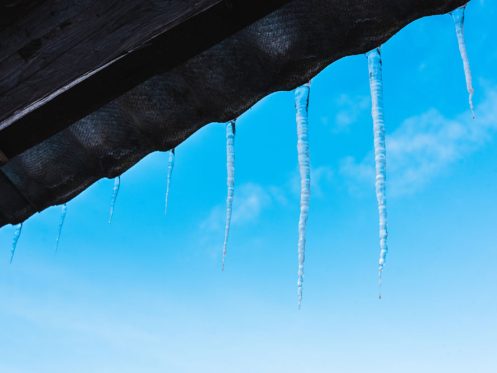Winter is here, and because we will be experiencing some rougher weather, now is the time to prepare your roof for the colder months. Preparing your roof for winter will not only protect your roof but will also keep your home from falling prey to any potential dangers and damages. So if you take certain precautions, you can get through the cold and rainy months of the South Texas winter and can minimize your chances of dealing with the hassles of roofing repair. Getting on top of the roof to fix it while it’s raining can be difficult for even the most experienced roofer, so it’s better to make preparations in advance.
Here are four tips on how you can prepare your roof for winter.
Inspect and Clean Your Gutters
Gutters are an important part of your roofing system and the rest of your home, so it’s a necessary step for regular roofing maintenance. Clogged gutters and debris accumulation can cause a number of problems that can occur at any time of the year, but they’re more likely to happen during the winter months. Water can pool on your roof, which can cause leaks and even water damage. But in the winter, your roof is more at risk because ice dams can occur.
Many of these issues can be avoided (or at least minimized) if you clean your gutters at least twice a year, and one of them should be sometime in the fall before the winter weather sets in. Make sure you clear out any leaves, branches, twigs, and other forms of debris from your gutters. You also want to check your drains and downspouts for clogs. Make sure every part of your gutter system is tightly fitted and secure because loose gutters can lead to water overflow. And if you can, install a gutter guard that will limit the amount of debris that falls in.
Trim the Trees Around Your Home
Tall trees and branches that hang over your house can lead to more debris accumulation on your roof and in your gutters. Even if you clean your gutters on a regular basis, you may still have to deal with leaves and branches that continue to fall into these areas (especially during the winter months). To avoid this extra hassle and to reduce the possibility of gutters getting clogged when the bad weather hits, you should take the time to deal with your trees as well.
Heavy limbs and dead trees can be hazardous during storms because they can lean toward your home and even crash into it (which can destroy certain areas). Squirrels and wild raccoons are known to live on or climb trees, so these long branches can serve as access points into your attic. To prevent damage and rodents from getting into your home, it’s a good idea to trim all the surrounding trees and tall bushes.
Check your Roof FLashing
Your roofing flashing is an essential component for this part of your home because it can prevent leaks. Any issues with this part of your roofing system can lead to serious water damage inside your home. The flashing is made of impervious material (such as aluminum or any type of galvanized metal), and it offers additional protection by directing the water off the roof so it doesn’t get into the rest of your home’s interior structure.
The flashing is located along various intersections of your roof, on all the joints, at the edges of any skylights, in parts where the chimney connects with the roof, as well as any similar areas. Cold temperatures and rain, as well as any strong winds, can sometimes cause the flashing to tear, loosen, lift up, and even corrode. To prevent damage and other issues related to leaking water (which can be expensive to repair), you should inspect the flashing to make sure everything is in working order.
Examine Your Roof Shingles
Like your flashing, your roofing shingles can experience wear and tear over time. Loose and missing shingles can cause a number of problems, which can be hard to deal with during the winter months (especially when the damage has already been done). You will be able to notice faulty or loose roofing shingles if their granules start to come off, which will end up in your gutters. You will also start to see signs of curling as well as leaves, twigs, and other forms of debris that get lodged underneath the shingles. All of them are signs that need to be replaced.
For more information about how you can keep your roof from getting damaged this winter, be sure to get in touch with Bayfront Roofing and Construction.
